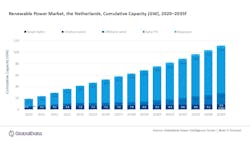Netherlands Accelerates Renewable Energy Expansion Toward 2035
The Netherlands is on track for one of Europe’s fastest clean-energy expansions, with renewable power capacity expected to nearly triple by 2035, according to new analysis from GlobalData. The firm projects cumulative renewable capacity will rise from 41.6 GW in 2024 to 111.7 GW in 2035, a compound annual growth rate of 9.4% driven largely by solar PV and wind development.
GlobalData’s report, Netherlands Power Market Trends and Analysis by Capacity, Generation, Transmission, Distribution, Regulations, Key Players and Forecast to 2035, identifies solar PV as the dominant source of growth. Installed PV capacity is forecast to increase from 28.6 GW in 2024 to 79.9 GW in 2035. Onshore wind is expected to grow more modestly, from 7.0 GW to 9.3 GW, while offshore wind is set for a significant jump—from 4.7 GW to 19.3 GW—supported by the country’s Offshore Wind Roadmap. Biopower capacity is projected to rise from 1.3 GW to 3.2 GW over the same period.
“Supportive instruments such as SDE++, the Offshore Wind Roadmap 2030–2050, and the National Energy and Climate Plan are catalyzing renewables growth in the country, while TenneT’s large-scale grid reinforcement program and the National Grid Congestion Action Programme are addressing bottlenecks in connecting new capacity,” said Mohammed Ziauddin, Power Analyst at GlobalData. “The government’s hydrogen strategy targeting 3–4 GW of electrolysis by 2030 and emerging battery projects will further enhance system flexibility.”
Conventional generation continues to shift as coal plants head toward phaseout, with capacity projected to fall to zero by 2028—two years ahead of the government’s 2030 deadline. Natural gas is expected to remain the primary balancing resource at around 20 GW through 2035, supporting reliability as variable renewable output increases. Nuclear capacity stays flat at 0.4 GW at the Borssele plant, though policymakers are evaluating a life extension and planning two new reactors to diversify future low-carbon supply.
Persistent challenges could slow progress, including grid congestion, curtailment pressures, rising network tariffs, and the need to scale storage and secure land for additional wind and solar development.
“With solar PV scaling rapidly, steady onshore wind additions, and a strong offshore wind pipeline, the Netherlands is expected to build a much larger renewable base by 2035,” Zia said. “Continued grid modernization, flexibility investment, and streamlined permitting will be key to turning the current pipeline into operating capacity at pace.”

